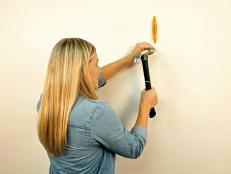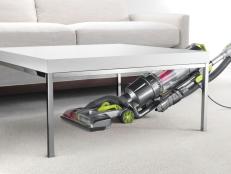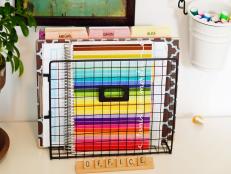10 Safety Tools Every DIYer Needs
Improve your workshop while exercising safe DIY during your next round of home improvement projects.

Hold up! Before you cut, climb, sledge, or rewire, take a peek at this list to learn what tools you should have to make your next project as safe as possible. These gadgets, kits, and systems take ordinary DIY to the next level, and make it easier to do projects safely for your own benefit and for those around you.
Insulated Electrical Screwdriver Set

Make certain that any hand tools involved in any electrical projects are manufactured with insulated handles. These products are highly regulated for safety, as the cushioned handle will help protect you against shock. Brands are required to include an official 1,000-volt rating symbol on products that pass the test, so keep and eye out for it and choose a qualified tool for your job.
Lead Paint Detector Kit

©iStockphoto.com/davidf
Always check for lead paint before scraping, sanding or refinishing surfaces painted before 1978. According to the EPA, 87 percent of homes built before 1940 are affected, and though it was used less and less up until it was banned, it still exists all around us. Lead paint detector kits are inexpensive and instantaneous in detecting the presence of lead — on walls, siding, vintage furniture, trim work — so take a minute to test before beginning a project. If it tests positive, consult with an expert to prevent the spread of lead in the air and soil.
Noncontact Current Detector

Old house, old wires, poorly labeled breakers — it's important to understand your home's electrical system, but how do you know if it’s hot or not? The quickest way to check if wires are live is to use a voltage detector to identify live currents. Check reviews before you purchase one. You’ll want a product that’s sensitive enough to tell you when a wire isn’t live (without getting confused by nearby live wires), and one that reads various voltages so you can have the intel you need whether you’re rewiring an outlet or a low-voltage doorbell. Many models also have LED flashlights that come in handy in hard-to-see spaces or during a power outage.
Infrared Camera
Go behind the scenes with an infrared camera. Infrared thermography can help you do a self-audit of your home to check for temperature variations in areas out of sight. If you suspect a water leak, an animal behind the wall, inadequate insulation, or even electrical fire, the camera will help map hot and cold spots so you can safely proceed with any project, repair, or rescue. There are infrared camera apps you can download to your phone.
Table Saw Push Block
Jen Woodhouse from The House of Wood is no stranger to power tools but always makes safety a priority. For many DIYers, table saws can be extremely intimidating, but with the help of a pushblock, you can protect yourself from the blade. Jen adds, “I feel so much safer using my table saw when I use the MicroJig GRR-Ripper pushblock because it grips and holds the workpiece as I send it through the saw. It keeps balanced pressure on the workpiece as it passes through the blade, allowing me precise control while keeping my hands clear and safe.”
Extension Ladder

Plan for your next climb by choosing the safest ladder for your needs. The most important thing to remember when you’re choosing an extension ladder is: Don’t go short. If the highest place you’ll be climbing is to the top of your home’s roof, it's best to choose a product that will extend at least seven feet longer than where you need to reach so you can properly access the area without sacrificing safety. Always take extra precautions if you’re using ladders in stairwells. And remember – use a fiberglass ladder if there’s a chance you’ll be in contact with electricity.
Dust Collection System
If you’re using saws, planers, and other power tools, you’ll kick up a big mess. Adam at LazyGuyDIY.com makes managing dust a priority. “Sawdust or drywall dust is no joke! If the area you're working in is not well ventilated, you need to hook up an industrial vac or a dedicated dust collector to make sure the air you're breathing is safe.”
Outlet Receptacle Tester

Test the condition of old outlets, or validate your new wiring efforts with the help of an outlet tester. These tools are less than $10, plug directly into the outlet, and give you the intel you need to keep your home safe. Make it easier and safer for every DIYer to get basic electrical work done right.
Screw Extractor Set for Stripped Screws

Adrian Henson
Raise your hand if you’ve stripped a screw and struggled to get it removed. Not only is wrestling a damaged screw frustrating but when you try to remove them with the wrong tools, you’re setting yourself up for potential injury or risking damaging your project. Add an extractor set to your drill bag, and use it to easily retract damaged screws safely and with reliability.
Good Lighting
Lighting is critical to safety if you’re in the workshop, building in the backyard, or getting things done after sunset. When an area isn’t equipped with good fixtures, use a combination of flashlights, stand lighting, and spotlights to illuminate your workspace and shadowed areas.
And Don't Forget Protective Gear

Emily Fazio
The protective wear we don while doing projects is as critical as the safety tools we use. Always choose a high-quality respirator, work gloves that really do 'fit like a glove', eye protection that’s both effective and comfortable, and ear protection with a high NRR rating. Use leather chaps when using a chain saw, and invite a great pair of steel-toed boots into your life, too.













































